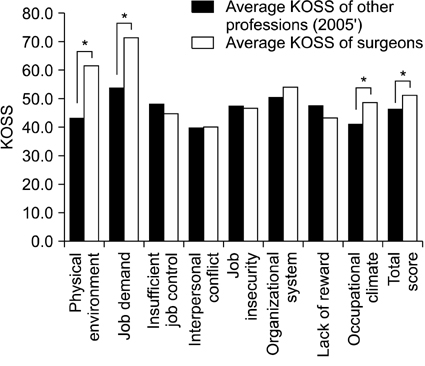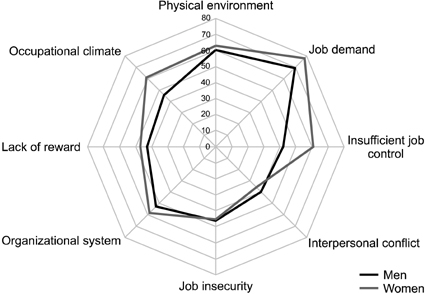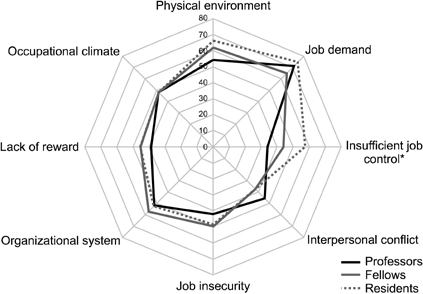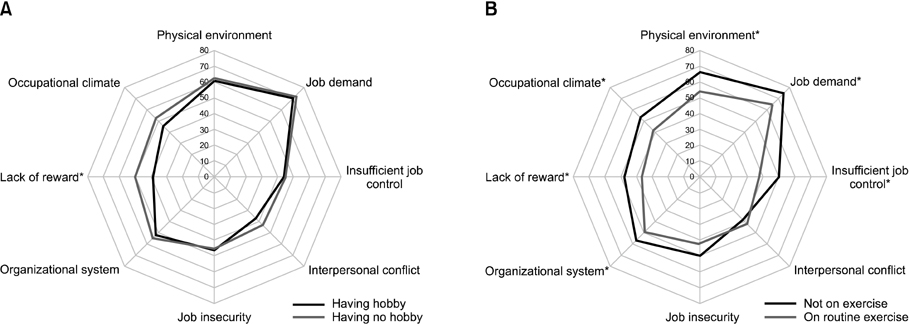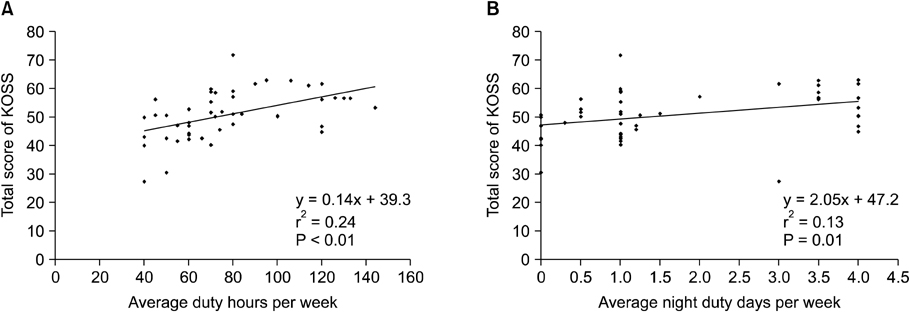J Korean Surg Soc.
2013 May;84(5):261-266.
Analysis of the occupational stress of Korean surgeons: a pilot study
- Affiliations
-
- 1Department of Surgery, Korea University College of Medicine, Seoul, Korea. drboo@korea.ac.kr
- 2Department of Medical Statistics, Korea University College of Medicine, Seoul, Korea.
Abstract
- PURPOSE
Surgeons serve one of the most challenging and stressful professions. Ineffective control of occupational stress leads to burnout of the surgeon. The aim of this study was to obtain preliminary data on the sources and the degree of stress of surgeons and to determine the feasibility of the survey.
METHODS
A total of 63 surgeons in our three affiliated hospitals were enrolled in this study. Fifty-five questions were used to assess the demographics, characteristics and Korean occupational stress scale (KOSS), which were prepared and validated by the National Study for Development and Standardization of Occupational Stress.
RESULTS
Forty-seven of the 63 surgeons participated in this study (74.6%). The mean KOSS score of the survey was 50.9 +/- 8.55, which was significantly higher than that of other professions (P < 0.01). Drinking and smoking habits were not related to the KOSS score. Doing exercise was related to a low KOSS score in terms of low KOSS total score (P < 0.01). Average duty hours (P < 0.01) and night duty days per week (P = 0.01) were strongly related to higher KOSS in the linear regression analysis.
CONCLUSION
This is the first study to evaluate job stress of surgeons in Korea. This study showed that Korean Surgeons had higher occupational stress than other Korean professions. A larger study based on this pilot study will help generate objective data for occupational stress of Korean Surgeons by performing a survey of the members of the Korean Surgical Society.
Figure
Reference
-
1. Kim SK. How to save surgical residents in crisis. J Korean Surg Soc. 2009. 76:207–214.2. Rosenthal T, Alter A. Occupational stress and hypertension. J Am Soc Hypertens. 2012. 6:2–22.3. Balch CM, Freischlag JA, Shanafelt TD. Stress and burnout among surgeons: understanding and managing the syndrome and avoiding the adverse consequences. Arch Surg. 2009. 144:371–376.4. Shanafelt TD, Balch CM, Bechamps G, Russell T, Dyrbye L, Satele D, et al. Burnout and medical errors among American surgeons. Ann Surg. 2010. 251:995–1000.5. West CP, Tan AD, Habermann TM, Sloan JA, Shanafelt TD. Association of resident fatigue and distress with perceived medical errors. JAMA. 2009. 302:1294–1300.6. West CP, Drefahl MM, Popkave C, Kolars JC. Internal medicine resident self-report of factors associated with career decisions. J Gen Intern Med. 2009. 24:946–949.7. Chang SJ, Koh SB, Kang D, Kim SA, Kang MG, Lee CG, et al. Developing an occupational stress scale for Korean employees. Korean J Occup Environ Med. 2005. 17:297–317.8. Cho JJ. Study for evaluation of validity and relability to Korean occupational stress scale. 2005. Incheon: Occupational Safety and Health Research Institute, Korea Occupational Safety and Health Agency.9. Cho JJ, Kim JY, Chang SJ, Fiedler N, Koh SB, Crabtree BF, et al. Occupational stress and depression in Korean employees. Int Arch Occup Environ Health. 2008. 82:47–57.10. LaPorta LD. Occupational stress in oral and maxillofacial surgeons: tendencies, traits, and triggers. Oral Maxillofac Surg Clin North Am. 2010. 22:495–502.11. Shanafelt TD, Oreskovich MR, Dyrbye LN, Satele DV, Hanks JB, Sloan JA, et al. Avoiding burnout: the personal health habits and wellness practices of US surgeons. Ann Surg. 2012. 255:625–633.12. Swetz KM, Harrington SE, Matsuyama RK, Shanafelt TD, Lyckholm LJ. Strategies for avoiding burnout in hospice and palliative medicine: peer advice for physicians on achieving longevity and fulfillment. J Palliat Med. 2009. 12:773–777.13. Weiner EL, Swain GR, Wolf B, Gottlieb M. A qualitative study of physicians' own wellness-promotion practices. West J Med. 2001. 174:19–23.14. Balch CM, Shanafelt TD, Dyrbye L, Sloan JA, Russell TR, Bechamps GJ, et al. Surgeon distress as calibrated by hours worked and nights on call. J Am Coll Surg. 2010. 211:609–619.15. Balch CM, Shanafelt TD. Burnout among surgeons: whether specialty makes a difference. Arch Surg. 2011. 146:385–386.
- Full Text Links
- Actions
-
Cited
- CITED
-
- Close
- Share
- Similar articles
-
- High Occupational Stress and Low Career Satisfaction of Korean Surgeons
- Occupational stress and related factors among surgical residents in Korea
- The Mediating Effect of Perceived Appraisal Support on the Relationship between Neuroticism and Occupational Stress in Firefighters
- A Study on Occupational Satisfaction and Stress of Visiting Nurses at District Health Centers in Chungnam Province
- A Study of Pilot-Efficacy

